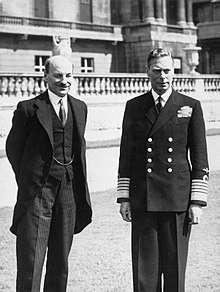Salisbury Convention
The Salisbury Convention (officially called the Salisbury Doctrine, the Salisbury-Addison Convention or the Salisbury/Addison Convention) is a constitutional convention in the United Kingdom under which the House of Lords will not oppose the second or third reading of any government legislation promised in its election manifesto.
Prior practice
From the Liberal split over the Irish Home Rule Bill 1886 until the effects of the House of Lords Act 1999 the second chamber had a Conservative majority (or, in later years, quasi-majority given the overall tendency of the crossbenchers to side with Conservatives) so manifesto commitments of the Liberal Party and Labour Party could not be sure of passing. Until the Lords threw out the Liberal budget in 1909, there had been a convention that they do not interfere on financial matters.[1] In the Parliament Act 1911 the peers lost their right to vote down a financial measure and their veto over other measures was reduced to a two-year delaying power, later reduced to one year by the Parliament Act 1949.
A Conservative majority of Lords used their maximum power, of delaying via wrecking amendments, certain Bills tabled by the 1929-1931 minority Labour ministry. Most legislation worked its way through by threatening use of the Parliament Act 1911.[2]
Creation

At the point of the landslide Labour general election victory in 1945, 16 of more than 761 peers qualified to sit in the House of Lords were Labour-affiliated.[3] This small minority was led by Lord Addison.
As Clement Attlee's Labour government had a clear electoral mandate to deliver the policies of nationalisation and welfare state measures, supporters and commentators supposed that the unelected House of Lords would not oppose the second reading of such legislation. Ministers and ex-ministers in the Lords echoed that the destruction and social plight caused by World War II called for more state spending. However, Lord Salisbury, Conservative Leader in the Lords, offered a lasting statement of principles, now regarded as a constitutional convention, as to the etiquette of how the House of Lords should treat bills fulfilling manifesto promises.[4]
Definition
Lord Addison and the pre-accelerated Lord Salisbury[n 1], the Conservative leader in the House of Lords from 1942 to 1957, both with memories of the troubles leading to the passing of the Parliament Act 1911, agreed principles as follows:
- any tabled bills set out in the governing party's manifesto may be subjected to possible short delay but pass; but anything else would be subject to full debate.[5]
In its modern form, the convention:
- permits the offering of reasoned amendments to a motion for second reading of a Government bill, provided such amendments are not wrecking amendments designed to destroy the bill.[5]
Evolution
Liberal Democrat dissent in 2005
After the Labour general election victory in 2005, the Liberal Democrats indicated that they did not feel bound by the Salisbury Convention as a result of decreasing voter turnout, the low share of the vote received by the Government, and the changes to the composition of the House of Lords introduced in 1999 by the Labour Government.[6]
Application to hung parliament coalitions and minority governments
It is mooted that during minority governments and post-election coalitions in which the main party in government does not have a clear majority the Convention does not hold; somewhat enhancing the Lords' power to delay and suggest redrafting of bills.[7]
Proposal to codify the Salisbury convention
In 2006, Tony Blair appointed his ex-Home Secretary, elevated to the Lords, Lord Cunningham to chair a joint committee (of both Houses) to investigate possibilities of formalising numerous conventions including the Salisbury Convention.[8][5] The proposals were dropped in favour of maintaining such conventions as part of the more ad hoc unwritten constitution.
See also
Notes and references
- References
- ↑ "Who Needs the House of Lords, meet peers rattling the Commons" Tanya Gold, The Guardian, 6 February 2016
- ↑ Higher School Certificate History by B. Hodge, B.A. (Hons.) and W.L. Mellor, B.A., Dip.Ed.
- ↑ "The political make-up of the House of Lords" Article citing total number of peers in 1938 by Mark Pack, Liberal Democrat, Lib Dem Voice, 10th February 2009
- ↑ "The Salisbury Convention – On Procedure and Politics". thoughtundermined.com.
- 1 2 3 "Salisbury Doctrine". Parliament.uk. 2013. Retrieved 2013-02-14.
- ↑ "House of Lords: conventions". House of Commons Library. 2007. Retrieved 2015-10-19.
- ↑ Elliott, Mark (June 2017). "Does the Salisbury convention apply during a hung Parliament?". Retrieved 20 June 2017.
- ↑ Lawrence, Jon (January 2007). "What is to be done with the second chamber?". History & Policy. Retrieved 9 December 2010.
- Notes
- ↑ (until 1941 Lord Cranborne, heir to the Marquessate of Salisbury, was a member of the House of Commons; he was eligible to sit in that house as his was a "courtesy title" rather than a peerage in its own right. In 1941 he was given a writ of acceleration so that he could become Conservative leader in the House of Lords as Lord Cecil, although he continued to be known as Lord Cranborne until he succeeded his father as Marquess of Salisbury in 1947)